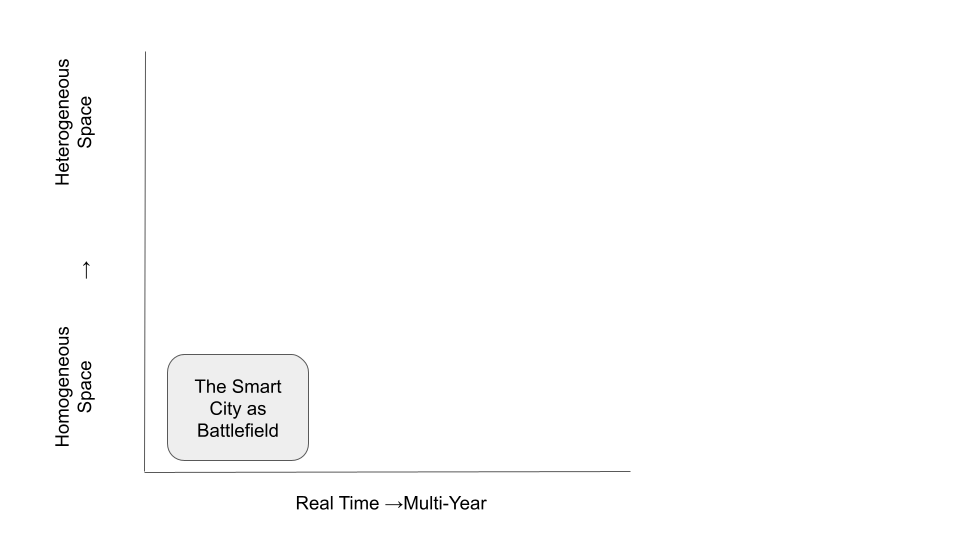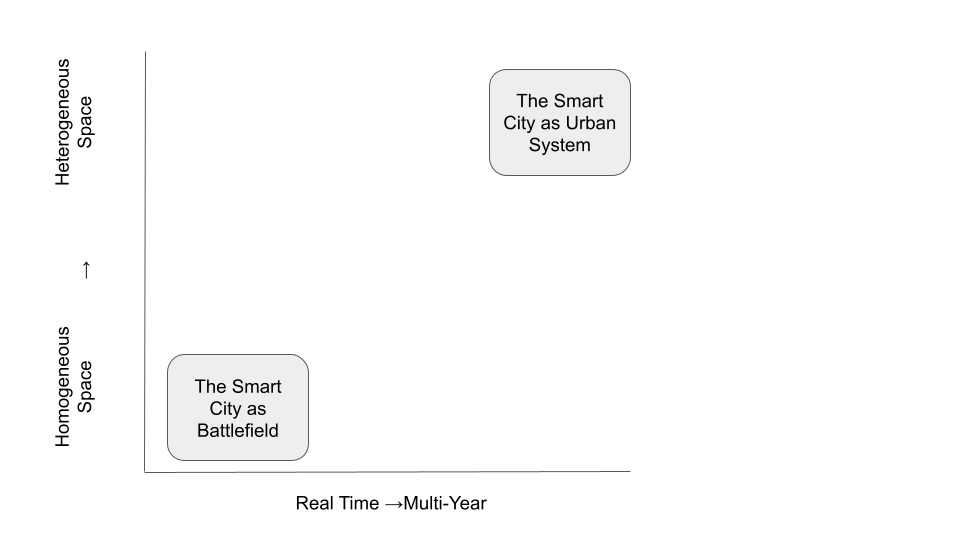Look for concrete implementations of the Smart City and you'll overwhelmingly see real-time dashboards of traffic and crime. This seems obvious — what else could it be, or what would be more useful? — but although they are part of the reality of most cities, the obsession with cars and guns is very much specific to the United States, as is the idea of real-time ubiquitous surveillance as the very essence of what it means to be "smart."
For most people in most cities, crime and traffic jams may be tragic or annoying aspects of their daily lives, but they aren't the defining factors of the urban experience. There were cities before cars, and there can be cities after cars, and data-driven predictive maps of crime have often proven to be useless if not counterproductive.
From before Ur to whatever form the city takes next the urban compact is this: governments provide liveable density through common goods, and in return they get increased economic performance and specialized skills. What they can or do provide has changed from city walls to sewage or high-speed internet, and it can be through direct city services or through private companies operating in the city, but the offer and the promise remains. To see as the natural deployment of advanced computing technology a sort of War Room with real-time surveillance of moving cars and people is a very parochial approach that has little relationship with how cities work, even in the cultures those archetypes come from.
So how do we take advantage of computational breakthroughs to make our cities better as cities?
The basic transformation is a change in coordinates - in the scale and focus of how the city government sees the city. Conceptually, the current model of the smart city is (for good historical reasons) similar to the military mindset:

In this conceptual vocabulary, the city is a space where cars and people move and events like crimes, traffic jams, and blackouts happen. The ultimate goal is to have a clear map where every individual unit or event is tracked in real time and predicted with precision.
This is an attractive, easy-to-visualize concept, but it's not very informative about how cities work or can work as engines of prosperity and well-being. We experience the city not as a map but as our environment: we stay or move through very different places with different and varying affordances —things we can do, things we can't do, things that are easy or difficult to do — that depend not only on the place but on the person. An apartment sits at the intersection of multiple variables: cost, accessibility, cost and dependability of utilities, ways and costs in which it can access educational services its inhabitants may need and affort, ways and costs in which it can access health services its inhabitants may need and afford, and so on in multiple ways. They all strongly influence the life of its inhabitants and of those around them, and in turn are influenced by slow processes, deliberate or not, that can take years or decades.
All of that is known, traditional, "boring" urbanism, but it's the core of how cities work, and it's where advanced IT, all the way to AI, would be most useful.

It may seem that shifting to using a large sensor net to track thousands or millions of events second-by-second is on a whole different level of technical sophistication than synthesizing livability metrics across multiple dimensions and tracking and managing overlapping large-scale infrastructural maintenance and development projects, but they are just differently difficult. Large-scale project management in practice is still a very shaky field. The merging of heterogeneous utility, demographic, economic, and real estate information, many from legacy systems, in coherent views of the world requires as much computational finesse as any facial recognition system. And being able to use computers to think better about the dynamics at the intersection of finance, engineering, and politics — the real place where urban futures are born — is still more challenge than reality.
Why attempt to make cities smart in this way, then, if the alternative is clearly understood, the technologies to implement it are at hand, and the increased information it provides is of immediate utility? The economic answer is simply that anything we can do to learn how to provide better urban public goods — affordable housing, good services, etc — at scale and more efficiently will have nonlinear impacts on the economy. This is obvious in underdeveloped cities where lack of basic services holds back progress, but it's also true in first world cities plagued by highly unequal services and unsustainable housing costs.
There's also a political answer: we live in the city, but we don't understand the city. We know what makes our lives more difficult. The rent is too damn high, we spend too much time commuting, internet connection is bad, there's nowhere to walk to or no good place to buy food. But we don't really know the city as a whole, its tradeoffs and bottlenecks, and, most importantly, we don't have clear, shared views of where it is going. There's no place, real or virtual, where somebody can city can go and see where services work in which way, where money is spent on maintenance, what expansions are planned in what time frames, where new buildings are being built and what radius of people isn't close to a hospital because one has just been closed.
In short, all productive political engagement requires a shared view of reality as a prelude to the discussion of goals and an evaluation of means. Cities have sometimes trouble gathering enough political support from their own inhabitants because their experience of the city is so fragmented that they end up focused on narrow issues and ignoring structural ones. We live in the same city in a physical sense, but it takes a lot of data processing and creative visualization models we have yet to figure out to live in the same political city.
What are the plausible next steps?
The challenge for city governments is to allow information access across areas and functions, and not just the usual ones of traffic or utilities. Money, planning, procurement, project history; at the scale in which cities live and improve or fail to, that is critical information, and one that is often isolated and fragmentary. City governments, to become smart city governments, need first to make it possible to access all the information relevant to how the city is performing as a city and what its past and projected futures are. It should also use its influence and power to gather and make available any relevant information it doesn't have: putting together data sets that others can't is also a way in which governments create public goods.
With access to this data, the challenge for companies is to make sense of it. There's more money spent on car-driving AI than on large-scale project management and complex system modeling AI, partly because the former is "sexier" but partly because the latter is harder and muddier. But even an initial synthesis of livability and forward-looking information, a basic sketch of the city as a platform for living changing across space, time, and financial scenarios, would change the way they see themselves and open up new lines of research, development, and implementation.
Every time we upgraded our cities and how we run them, societies grew as well. That's what cities are, ultimately: they speed up the future. The choice between using our newest tech to control or to nurture them, if surveillance or shared understanding are to be the way governments relate to them, will say much about their future, which is also ours.
Post-credits scene
I'm always happy to chat about these things. Drop me a note.
None